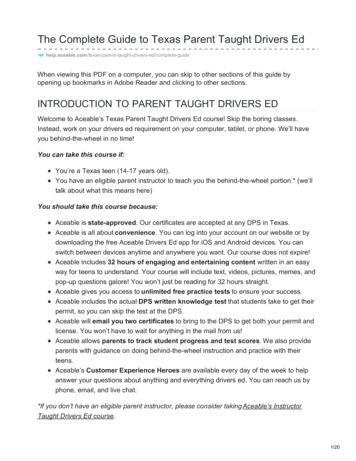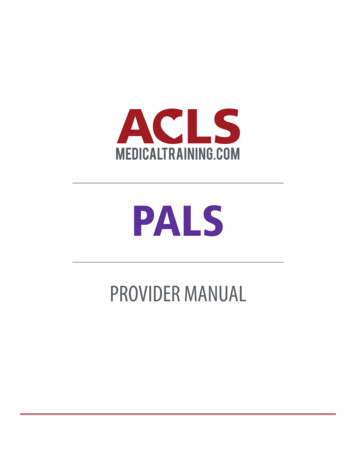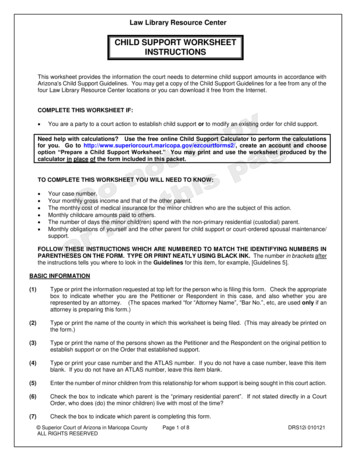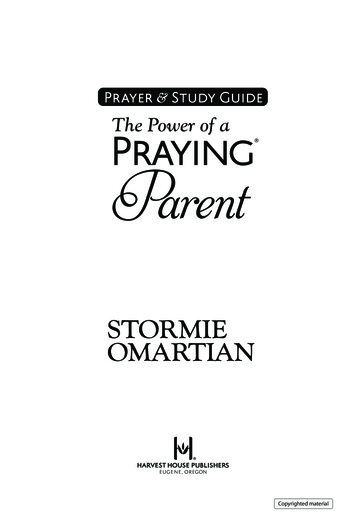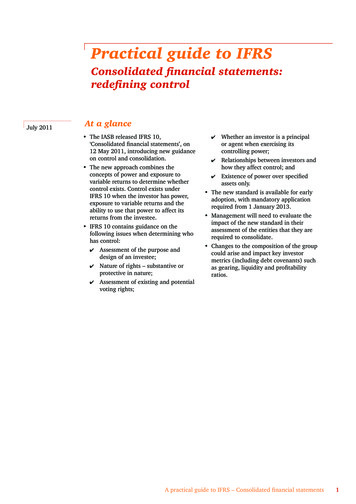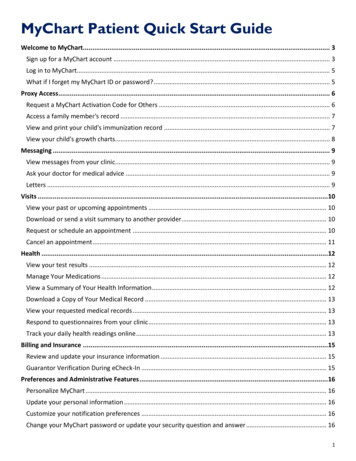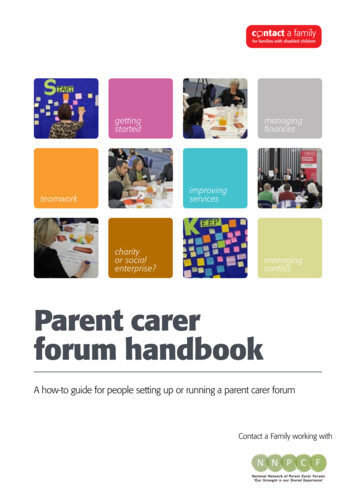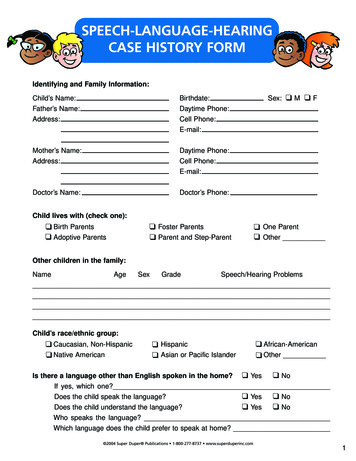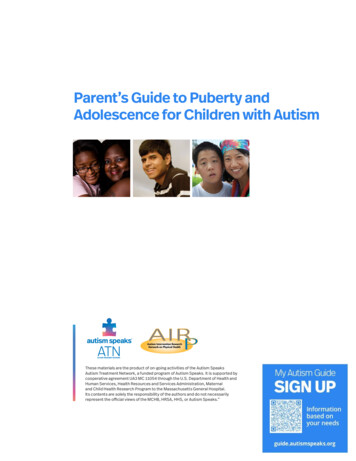
Transcription
Parent’s Guide to Puberty andAdolescence for Children with AutismThese materials are the product of on-going activities of the Autism SpeaksAutism Treatment Network, a funded program of Autism Speaks. It is supported bycooperative agreement UA3 MC 11054 through the U.S. Department of Health andHuman Services, Health Resources and Services Administration, Maternaland Child Health Research Program to the Massachusetts General Hospital.Its contents are solely the responsibility of the authors and do not necessarilyrepresent the official views of the MCHB, HRSA, HHS, or Autism Speaks.”
Puberty and Adolescence Resource presented by the Autism Speaks ATN/AIR-PAUTHORS’ NOTEThis tool kit was developed in response to requests from parents for resources related to puberty fortheir child with ASD. Although there are excellent resources on puberty, we found gaps in the availableresources related to autism. Our goal was to provide information that was limited or not availableelsewhere. This Puberty and Adolescence Resource, also known as the [P.A.R.] Tool Kit, representsa joint effort of Parents and Professionals from the U.S. and Canada, to create what we hope is anintelligent, yet easy to read and share document for those who support an adolescent with an AutismSpectrum Disorder.Some of the challenge in creating this tool kit involved the personal nature of puberty and sexuality.This is obviously a topic that requires sensitivity, and each family should address it within their ownvalues and morals. We wanted to develop a tool kit that could provide general information, which isnot easily found, but which is also specific enough to be as useful as possible for families.We have tried to be respectful in the presentation of information. Still, we realize that some of theimages and content in this tool kit could be overly personal for some parents. Of course, we encourageeveryone to go through the material first, deciding what is most useful in his or her parenting styleor in sharing with their child. You are also encouraged to seek guidance from your family’s team ofmultidisciplinary specialists, social workers, family navigator, spiritual leader, etc. It was our goal tostrike the best balance possible, knowing that some parents will prefer less information, and thatothers will want more!We want to especially thank the parents and students who provided feedback on the development ofthis tool kit. Without their input, it simply could not have been completed.For further info and resources visit: www.autismspeaks.org/atn ncerely,The ATN/AIR-P Puberty and Adolescence Resource Workgroup(Pictured left-right top) Parent Partner Authors- Kameena Ballard-Dawkins, Amy Kelly, Charlene Prochnau,Alicia Curran, BS and Rich Hahn (bottom) Professional Authors Dr. Kristin Sohl, Lisa Voltolina M.S., CCRP,Dr. Shawn Reynolds, Dr. Lisa Nowinski, Martha Y. Porras and Yolan Parrott Msc OT, OT(C).p.1
Puberty and Adolescence Resource presented by the Autism Speaks ATN/AIR-PHOW TO USE THIS TOOL KITA “Tool Kit” is a set of print or electronic materials that are designed to support families and providersof children affected by autism in the management of their care. Tool kits may also be targeted directlyto the children to educate them or support them in the management of their own care. Tool kits provideinformation on a focused topic with a specific goal such as supporting a family through the puberty andadolescent stage for their child with ASD. Below are suggestions on how this tool kit might be best used.Please visit our ATN/AIR-P Tool Kits page to learn more about all of the tool kits we have available forparents and professionals to date.Keep the P.A.R. tips, scripts & visualsnear by to help you explain thechanges that are happening andwhen they might take place.Check the appendices at theend for more informationand resources on the topicsmentioned in this tool kit.Use this Tool Kit when visitingyour primary care physician,pediatrician, IEP team, teachers,caregivers, spiritual advisors andpsychiatrist to advocate for theneeds of your child.Read through the P.A.R. ToolKit to help you understandmore about puberty andadolescence.Use the scripts to engageyour child or individual yousupport who has autism.p.2
Puberty and Adolescence Resource presented by the Autism Speaks ATN/AIR-PTABLE oF CONTENTSAUTHORS’ NOTE.1HOW TO USE THIS TOOL KIT.2TABLE OF CONTENTS.3INTRODUCTION.4PUBERTY VS ADOLESCENCE.5PARENT PARTNER NOTES.6PARENT PARTNER NOTES CONT’D.7BODY CHANGES .8BODY CHANGES-CONVERSATION SCRIPT.8SELF-CARE AND HYGIENE.9MENSTRUATION (HAVING A PERIOD).14PUBLIC OR PRIVATE?.16STAYING SAFE: STRANGERS, SECRETS AND TOUCH.19SAFETY PLANNING FOR RUNNERS AND WANDERERS: ELOPEMENT.21SAFETY PLANNING FOR INCREASED AGGRESSION.22THERAPEUTIC SERVICES AND FAMILY COUNSELING.26INTERNET SAFETY.28SAFETY PLANNING FOR INTERNET USERS.28AS ATN/AIR-P FOR FAMILY-PATIENT CENTERED CARE.29RESOURCES.30ACKNOWLEDGEMENTS.31p.3
Puberty and Adolescence Resource presented by the Autism Speaks ATN/AIR-PINTRODUCTIONPuberty can be a time of mixed feelings for parents and pre-teens. It may be a time of pride and celebrationas well as a time of worry and confusion. It is hard for pre-teens to understand the many changes thatcome along with puberty. Also, parents may feel unsure of how to explain these changes to their child.Parents of pre-teens with ASD may find this time of transition especially difficult. The physical andemotional changes of puberty may seem out of sync with their child’s social and academic development.Parents need the skills and confidence to talk about puberty and sexuality in order to confidently teachimportant life skills, including appropriate public and private behaviors, natural body changes and healthysocial and romantic relationships.A key to keep in mind is that while individuals with ASD often progress in ways that are different fromother children, their bodies generally develop at a similar speed as their peers. Boys and girls experiencechanges in their bodies whether or not they have ASD. Children with ASD may have unique responsesto what is happening to their bodies and may need additional guidance when navigating this time oftransition.All parents eventually face the challenge of teaching their children about the natural changes of puberty.However, parents of pre-teens with ASD may need the help of additional strategies to ease the transition.Our aim in developing this tool is to provide guidance on the subject of puberty that can be directlyapplied to pre-teens with ASD. In doing so, we hope to increase families’ understanding of puberty andtheir ability to adapt to these changes with confidence.This tool kit was a collaborative effort of parents of teens and pre-teens with ASD, physicians specializingin ASD, special educators and allied health professionals. It was designed to provide general informationacross a wide range of parents in hopes to provide a comprehensive perspective on puberty andadolescence. We recognize that many parents will deal with more significant challenges that we do notaddress in this tool kit, including but not limited to matters of sexual orientation and family planning.Therefore, this tool kit should not be seen as a substitute for personalized support when challenges aremore specific and/or significant. It also does not take the place of any consultation with a physician,school or mental health provider, which is strongly recommended when needs are great.Did You Know?Several parents volunteered to collaborate on the development and writingof this tool kit. You will hear from them as a Parent Partner throughout thistool kit providing us with their personal tips and stories.p.4
Puberty and Adolescence Resource presented by the Autism Speaks ATN/AIR-PPUBERTY vs. ADOLESCENCEPuberty and adolescence can be tricky concepts. Believe it or not, they do not mean the same thing anddon’t necessarily happen at the same time in development! Before we dive into more specific content,let’s define these terms.Puberty refers to the physical changes in the body that make a person able to sexually reproduce.Adolescence is the period of emotional and social transition between childhood and adulthood.This difference is important to keep in mind, especially when parenting pre-teens (sometimes referredto as tweens) with ASD. People with ASD often experience delayed development of social and emotionalskills. They may not achieve the transition of adolescence until their late teens or early twenties. However,they will most likely undergo the physical changes of puberty within the typical time frame, which can beas early as 10 or 11 years of age.What does all this mean? Simply put, many teens with ASD may experience the sensations of a physicallymature body without the social, emotional or psychological maturity to understand these sensations.Parent Partner’s Tips:Body Changes Start early with teaching privacy. With siblings and therapists often around, privacy is difficultto find, but is absolutely appropriate at a certain point in life. Help your child learn when thatis and how to safely obtain it. Model appropriate hygiene behavior. Let your child watch you when you shave, put ondeodorant or any other activities that maintain good hygiene if you feel it’s suitable. Use the correct language for body parts and body functions. Our children are all going togrow up to be adults one day and need to be taught proper terms for mature subject. Start practicing early. The sooner you and your child can develop a routine, the sooner he orshe will get used to it. Teaching skills early makes it easier to incorporate them into everydaylife.p.5
Puberty and Adolescence Resource presented by the Autism Speaks ATN/AIR-PParent Partner’s Personal Story:I never imagined back in 2002 when my sweet little 6 pound 11 ounce baby Annie was born that 12 yearslater, I would be intensely teaching her, step by step, how to shower independently, apply deodorant andpractice changing menstrual pads. That’s right. This is all in anticipation of The Big P. PUBERTY.Once again, I find myself in the never-ending abyss of autism, not knowing what to expect in Annie’snext stage of life. Although somewhat intimidating, it is also very exciting to see her blossoming into abeautiful young lady, and I feel privileged to go through this journey with her. Annie, like many of ourchildren with ASD, has defied expectations - she learned to start talking when she was ten, she can nowread and write, she loves to cook and she is always talking about “Mama and Annie”. It’s wonderful.I hope this resource will help to remind you of the silver linings your child gives to you and your families.(It helps to remember these when we want to pull our hair out during the inevitable frustrating times!)On the next page are some of the things I’ve done so far to prepare Annie for becoming a young woman:-Amy K., Parent Partner, Philadelphia, PAp.6
Puberty and Adolescence Resource presented by the Autism Speaks ATN/AIR-PFor girls who are beginning menses (menstruation or periods), it is helpful if the caregiver can see adoctor who specializes in adolescent care and birth control BEFORE the actual event occurs. I had seena specialist at my Children’s Hospital in our Adolescent Specialty Care division three months before mydaughter began her period, and THANK GOODNESS! Once it started, I was able to call the doctor directlythat day and move ahead with the plan we had already discussed would work best for my daughter(in our case it is birth control pills that regulate her period to come fewer times a year). This gave meimmediate peace of mind that she is protected, and that we at least have a manageable schedule to dealwith an unpredictable journey through puberty.My daughter began her period when she was 12 ½ years old and is minimally verbal. It’s hard for her totell me when she is uncomfortable but I was reminded to watch for other signs. She indicated to meshe was in pain by rubbing her tummy and I knew that was her way of telling me she had cramps so I kepther on a mild pain reliever (Ibuprofen). I also, to my dismay, found that she had completely removed ANDshredded her soiled pad the next morning when she woke up before she came to get me. That told meit felt really uncomfortable and I needed to consider having her use the bathroom in the middle of thenight, or at least get up before she did, so I could wake her and get her changed and comfortable. It’s alllearning!Did you know that they make underwear specifically designed to help keepmenstrual pads in place and more comfortable? This is KEY when you arelooking at young women who have sensory issues to begin with and who maynot fully understand what is happening in their bodies during menstruation,or how to have appropriate hygiene. Here’s a link to one type, but if youGoogle search, there are other Rise-Menstrual-Underwear/dp/B008V1XNSG/ref pd sim sbs hpc 1?ie UTF8&refRID 0TGWC2RZPB212H6YW2VJp.7
Puberty and Adolescence Resource presented by the Autism Speaks ATN/AIR-PBODY CHANGESIt is important to give your child time to process the idea of his or her body changing before pubertyactually starts. Boys will typically show signs of puberty around the age of 11 or 12. Girls usually experiencechanges in their bodies earlier, around the age of nine or 10.It is natural for some parents to feel somewhatuncomfortable speaking to a young child about hisor her body. To reduce discomfort, consider talkingwith your spouse, older children or trusted familyor friends about your family’s values, practices, andhow to develop them in your child. Establishingfamily values (i.e. no pregnancies before marriage,etc.) can guide your interactions with your childand prepare you ahead of time for any questionsthat may come up.Perhaps what may be just as important asestablishing family values and practices is togain a basic understanding of the body changesassociated with puberty. One of the foundationsfor introducing the topic of puberty is to explainthe changes that will happen to your child abouthis or her body parts. Make sure you can speakclearly, in a way your child can understand, so he orshe will know what to expect as they grow.This chart can be used as a timeline, toshow your child how hair will grow onmale dy Changes-Conversation ScriptGet started by checking the picture resources we’ve provided. Then, add additional resources youdiscover through family, friends, and your community- that would be appropriate for your child based ontheir age, learning needs and abilities.Starting a conversation about body changes is tough. Don’t know where to begin? Here’s a script to helpyou get started! (You can modify this depending on your child’s maturity and verbal skills, of course.)We’re going to talk about some things that happen to everyone, even me. People’s bodies change asthey grow up, and I want to tell you about it so you know what’s happening when your body startschanging too. It happens differently for everyone, and that’s okay. The important thing is that we talkto each other, and that you know you can ask me questions whenever you want.For the less verbal child with ASD, adjust language and information to the level of the child and addvisual supports. Start saying something like ”the rule is that your body will change and I want toshow you how. Everyone’s body changes as we become a grown up. Your body is going to change likethis (using pictures). You will start to look more like a grown up body like me (or another person).”p.8
Puberty and Adolescence Resource presented by the Autism Speaks ATN/AIR-PSELF-CARE AND HYGIENEAs puberty begins, there are many new challenges for kids to understand. Many children with ASDstruggle with the changes in self-care and hygiene routines that is necessary for managing puberty. Hereare some of the changes to expect and some ideas to help your child deal with them.General hygieneWith puberty come sweat, oily skin, and pimples. Children will need to start bathing or showering dailyto keep their bodies clean. Often, children with ASD are not aware of the social impacts poor hygienemay create. If it is appropriate, talk to your child (or set up a routine) about why he or she needs to bathemore frequently. Social Narratives can be a helpful way to teach children about why hygiene is important.If getting your child to become motivated to bathe is a struggle, you may need to introduce daily bathingas a “new house rule”, provide visual checklists and reminders to bathe, wash thoroughly, use soap andshampoo, etc. At this age, it may be increasingly hard for you to monitor how well your child is washinghis or her body - another reason to teach independent bathing early.This showering narrative can be used as a visual aide or as individual remindercards to encourage good hygiene.All text and illustrations are copyrighted by the Vanderbilt Kennedy Center (VKC) and cannot be used in another contextwithout written permission of VKC Communications (kc@vanderbilt.edu, 615-322-8240).p.9
Puberty and Adolescence Resource presented by the Autism Speaks ATN/AIR-PShavingThis can be extremely tricky, especially if your child struggles with tactile sensations. You will need toteach your child how to shave safely, as pain or even a cut may lead to future avoidance. This may be anarea where children require assistance until you feel confident that they can shave safely on their own.Try different razors and shaving creams to find one your child prefers and accepts. Often, an electricrazor is a better option for teenagers just starting out. Keep in mind that some people with ASD maybe sensitive to the sounds of electric razors. If your child is very averse to shaving, you may need towork on increasing his or her comfort level first. To do this, start gradually with single steps (i.e. put onshaving cream and rinse off), short periods of time (i.e. turn razor on for 5 seconds and then off), orsmall areas (i.e. put on shaving cream and shave a small area). At first, your child may only tolerate thesesmall exposures. Gradually work your way up and be patient. If shaving is not an option, these sameincremental steps could be used with depilatory creams, which may have less of a sensory impact andrequire less fine motor skills.Parent Partner’s Personal Story:“I am the proud mother of a 14-year-old son with autism. There have been several times during myjourney of raising a child with autism that I find myself in unknown territory. I find myself at one of thoseplaces now: PUBERTY!I have so many questions and concerns. How willI handle him during times of moodiness, or evenaggression, now that he is bigger than I am? Will Iever get his acne under control? Is he scrubbing allthe right places when showering and using enoughdeodorant? What level of independence andaccountability is appropriate for him? How willI handle the time when he starts experimentingwith masturbation? My list of questions could goon forever.I do not have all the answers. However, I do knowthat across all the challenges we have faced duringother transitions in his life, we have always figuredit out. I have to keep focused on what is important:watching Samuel grow into a wonderful youngman, who I am proud of, and being okay with nothaving all the answers today!”-Alicia C., Parent Partner, Columbia, Missourip.10
Puberty and Adolescence Resource presented by the Autism Speaks ATN/AIR-PWearing deodorantAdding a new step to the morning routine can be tough - your child may already have a well-establishedroutine by this age. This can be a very crucial step when managing body changes. Try a variety ofdeodorants and antiperspirants (e.g., sticks, gels, sprays, etc.). Let your child pick which one he or sheprefers - this may be helpful in motivating him or her to use it. Many teens do better when given achoice. Again, you may need a visual reminder for your child to put on the deodorant. You may alsoneed to introduce it as a “new house rule” or provide rewards until your child integrates this step intohis or her regular routine.Image courtesy of Vanderbilt Healthy Bodies Tool Kit for Boys:www.vanderbilt.com/healthybody boyWearing a braMost girls will accept this change quite well. However, adding a new item to the dressing routine cansometimes be tricky. Try a few styles of bra with your daughter to find one that fits well and that shefinds comfortable. You may need to start with a less supportive bra, or training bra, until she is tolerantof a more supportive bra. Explain that this is a part of becoming a woman and experiencing bodychanges. You may need to re-introduce a visual schedule or check list with steps for dressing to remindher to put on the bra while getting dressed.p.11
Puberty and Adolescence Resource presented by the Autism Speaks ATN/AIR-PSelf-care and Occupational TherapyMany children with ASD need support to be successful in coping and adapting to body changes. Anoccupational therapist is an excellent resource to address many of these changes. Occupational therapy(OT) focuses on self-care, productivity and leisure. For children transitioning into young adulthood,occupational therapy could include: establishing independence in hygiene, dressing, sleeping, sexualhealth, completing chores, volunteer or paid work and socializing with friends, peers, co-workers orfamily. Occupational therapists work collaboratively with children and their families to set goals andstrategies tailored to meet your family’s specific preferences. Below is a chart preview from the ‘AutismSpeaks Occupational Therapy Tool Kit’ that can be used as a visual guide to see if OT could be a resourcefor your family.Wheeland, A. & OT Practicioner Advisory Committee. (2014). Occupational Therapy Across theLifespan: Autism Speaks Family Services Tool Kit. Available at pational-therapyp.12
Puberty and Adolescence Resource presented by the Autism Speaks ATN/AIR-PMENSTRUATION (HAVING A PERIOD)Your daughter with ASD will experience a lot of changes during puberty, just like other girls do. Gettingher first period is likely to be one of her biggest milestones during this time. ASD does not affect whengirls start their periods, so many girls with ASD will most likely have her first period between the age of9 and 11 years old.Since it is impossible to know exactly when your daughter will get her first period, it is important to takeher personal preferences, personality and her level of understanding into consideration when decidingwhen to discuss this topic. Keep in mind that pre-teens with ASD often need extra time to adjust tochanges and new information, and they sometimes can become fixated on events that are unpredictableand potentially frightening. Since the first period usually comes about 12 to 18 months after startingbreast development, it is often a good time to start discussing it as she is getting used to wearing a bra.It is crucial to prepare your daughter for her first period ahead of time. Make sure you pick the rightmoment to prepare her for this. Consider what point in time will minimize the stress and anxiety ofanticipating her period, while also maximizing her ability to process this information. There is no rightway to do this for every child, so use your best judgment!Once you are ready to talk to your daughter, there are some key topics to addressWhat does “having your period” mean?If girls don’t know or understand what periods are, they may be frightened that they are sick or injured.Making sure your child understands that monthly bleeding is absolutely normal, natural and healthyis crucial to reducing anxiety. Consider whether a social narrative might be helpful for your daughter,both as an instructive tool and as a reminder of what to expect each month.Stomach cramps and body aches are normal.Try to prepare your daughter for the physical sensations associated with monthly periods. Abdominalcramping, feeling tired and experiencing breast, stomach or low back soreness are all normal sensations,even though they are not very comfortable! Teach your daughter appropriate strategies for relievingdiscomfort. For example, it may be fully appropriate for your daughter to use a hot water bottle toreduce cramps or body pain independently, but pain-relieving medications should only be used withpermission and under parental supervision. Of course, if these symptoms appear to be severe orinterfere with daily activities, you should speak to her medical provider for additional options.Pre-menstrual syndrome (PMS) is normal, too.Girls with ASD can experience the same range of PMS symptoms as typically developing girls. However,their symptoms may lead to challenging behavior if they have trouble regulating their emotions. Likemost girls, your daughter may feel cranky, depressed, tired and find it difficult to concentrate. If sheunderstands why she is feeling this way, your daughter may feel more in control of her changing body.A social story, specific to your child’s symptoms, may help. As with physical symptoms, you shouldspeak with your child’s medical provider if symptoms of PMS are severe or interfering with daily life.p.13
Puberty and Adolescence Resource presented by the Autism Speaks ATN/AIR-PWhat are pads and tampons?Once your child’s periods have started, she will need to know what pads and tampons look like andhow to use them. Consider going to the grocery store together to pick out different types to try. Girlsof any age can use tampons, but they take practice and require regular changing to prevent any seriousillness that could happen as a result of not changing your tampon frequently enough. It is often easierfor girls who have newly started their period to use pads in the beginning, since they require lessskill to replace and are, in and of themselves, a visual reminder to be changed. If your daughter usesvisual supports, a visual schedule showing the steps involved in changing a pad, tampon or alternativesanitary product like a Diva Cup (a reusable menstrual cup that is a safe hygienic alternative) may bevery useful.Use this chart as a visual aide during menstruation, to help communicateduring her puberty. Vanderbilt Kennedy Center. All rights reserved. Used with It will be helpful to review this information with your child frequently, especially during the first severalmonths after she starts her period. Reviewing the sensations, self-care and hygiene techniques eachmonth will help turn these new skills into a habit. Experiencing a first period can be stressful anduncomfortable for your child. Natural hormonal changes may make it harder than usual for her to copewith unpleasant sensations or emotional states. Above all, remain calm and patient. This may be hardfor you to talk about and for her to understand, so it may be stressful for both of you. Your continuedsupport will ease the discomforts of this important life transition.p.14
Puberty and Adolescence Resource presented by the Autism Speaks ATN/AIR-PParent Partner’s Personal Tip: MenstruationThis is a worthwhile activity to do with your daughter after you’ve begun discussions about her firstperiod.Take your daughter with you to the grocery store the next timeyou need to purchase pads or tampons. Select other grocery itemsas usual and then head to the aisle for sanitary products. Showyour daughter which
don’t necessarily happen at the same time in development! Before we dive into more specific content, let’s define these terms. This difference is important to keep in mind, especially when parenting pre-teens (sometimes referred to as tweens) with ASD. People with ASD often experience delayed
